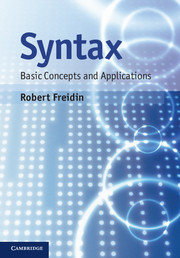Book contents
- Frontmatter
- Contents
- Preface
- Acknowledgements
- 1 The computational nature of human language
- 2 Knowledge of language as an object of inquiry
- 3 Categories and constituents
- 4 Phrase structure theory
- 5 The structure of clauses
- 6 The syntax of Spec-TP
- 7 Head movement and the structure of root clauses
- 8 Wh-movement
- 9 Ellipsis
- Notes
- Glossary
- References
- Index
9 - Ellipsis
Unpronounced syntax
Published online by Cambridge University Press: 05 November 2012
- Frontmatter
- Contents
- Preface
- Acknowledgements
- 1 The computational nature of human language
- 2 Knowledge of language as an object of inquiry
- 3 Categories and constituents
- 4 Phrase structure theory
- 5 The structure of clauses
- 6 The syntax of Spec-TP
- 7 Head movement and the structure of root clauses
- 8 Wh-movement
- 9 Ellipsis
- Notes
- Glossary
- References
- Index
Summary
Problems worthy
of attack
prove their worth
by hitting back.
Piet Hein, Collected Grooks, vol. 1.
In the syntactic theory developed over the last eight chapters, deletion is analyzed as a syntactic operation that applies after Spell-Out on the PF side of the derivation. By hypothesis, it erases all the remaining features of a syntactic constituent (i.e. its phonetic, morphological, and syntactic features). One fundamental function of deletion is chain reduction in PF representation, which is required by the Principle of Full Interpretation. Such deletions are thus obligatory. However, there are also instances of deletion that do not appear to involve nontrivial chains. One case that came up briefly at the end of Chapter 3 concerned the deletion of a single verb in the second clausal conjunct of a coordinate structure, which goes under the rubric of gapping. This is illustrated in (1b), where the main verb of the second clausal conjunct is deleted.
a. Jonathan left yesterday and Mary left the day before.
b. Jonathan left yesterday and Mary left the day before.
Although the verb left is not pronounced in the second conjunct in (1b), it is nonetheless interpreted at LF as the main verb of that clausal conjunct. Obviously (1b) has the same LF representation as (1a). Gapping is one form of ellipsis in natural language, which allows a single LF representation to map onto two PF representations, one a reduced version of the other. Unlike chain reduction, ellipsis via deletion is an optional operation. Minimally, both ellipsis and chain reduction involve the erasure of phonetic features in a PF representation.
Information
- Type
- Chapter
- Information
- SyntaxBasic Concepts and Applications, pp. 211 - 253Publisher: Cambridge University PressPrint publication year: 2012
